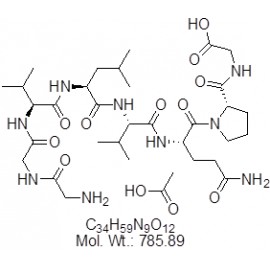No products
Product successfully added to your shopping cart
There are 0 items in your cart. There is 1 item in your cart.
Proteins and Enzymes
- Protein Control Ligand
- Pathway Inhibitors
- Enzyme Inhibitors
- Kinase Inhibitors
- Protease
- Synthase
- p18
- p38
- p53
- p70
- p90
- Peptidase
- Carboxyl and Decarboxylases
- Ceramide Turnover Enzymes
- Chromatin Modifying Enzymes
- Cyclic Nucleotide Turnover Enzymes
- Glycerophospholipid Turnover Enzymes
- Hydroxylases
- Ubiquitin-Activating Enzyme
- Adenosine Deaminase
- Clathrin
- Nuclease
- p68
- ACE
- COX
- DHFR
- Neprilysin
- NF-κB
- RAF
- RAS
- Reductase
- ROR
- Topoisomerase
- Transferase
- Protein Inhibitors
- Transporter Inhibitors
- Cell Inhibition
- Synthase
- Receptor Tyrosine Phosphatases (RTP)
- AChE
- Peptidase
- Autophagy
- Toll-Like Receptor (TLR)
- Enzyme Inhibitors
- Function Modulators
- Activators
- G Protein-Coupled Receptor Ligands
- 5HT Receptors
- Adrenoceptor
- Angiotensin Receptor
- Cannabinoid Receptors
- CCK Receptors
- DA Receptors
- EAA Receptors
- Ghrelin Receptors
- GABA Receptors
- Histamine Receptors
- Leukotriene Receptors
- Metabotropic Glutamate Receptors
- Motilin Receptors
- Muscarinic Receptor
- Neuropeptide Receptors
- Opioid Receptors
- Orexin Receptors
- Orphan Receptors
- Prostanoid Receptors
- Proteinase-Activated Receptors
- Purinergic Receptors
- Ryanodine receptor
- Sigma Receptors
- Thrombin Receptor
- Vaniloid Receptor
- VIP and PACAP Receptors
- Neurotensin Receptors
- Urotensin Receptor
- Imidazoline receptor
- SMO Receptors
- Apelin Receptor
- β-arrestin/β2-adaptin
- KDM4
- Glucocorticoid Receptor
- Laminin Receptor
- AHR
- Amylin Receptor
- Bombesin Receptor
- Bradykinin Receptor
- CFTR
- CGRP Receptor
- CRFR
- Endothelin Receptor
- Ephrin Receptor
- Farnesoid X receptor (FXR)
- Glucagon Receptor
- Nuclear Receptor Ligands
- GDNF Receptors
- TNF Receptors
- Transcription Factors
- Chemokines
- Cytokine Receptors
- Biomarkers and Buffer Solutions
- Molecular Probes
- Stem Cell Research
- Alzheimer's Disease
- Apoptosis
- Cancer Research
- Epigenetics
- Metabolites
- PET/SPECT Imaging Precursors
- Customized Screening Library
- Ultra Pure Pharmacological Standard
- Tissue Microarray (TMA)
- Proteins and Antibodies
- Primary Cells
- ELISA KIT
- Natural Products
- Lab Equipments
- Humanized Mice for PDX Platform
- Rare Chemicals
- Custom Synthesis
- Antibacterial
- Antifungal
- Antioxidant
- Antiviral
- Molecular Glues
- PROTAC Linker
- SARS-CoV
Human IGF1 / IGF-I Protein
10598-HNAE
Activity: (1) Measured by its ability to bind human IGFBP4-His (Cat:10967-H08H) in a functional ELISA. (2) Measured by its ability to bind mouse IGFBP4-His (Cat:50250-M08H) in a functional ELISA. (3) Measured by its ability to bind Cynomolgus IGFBP1-His (Cat:90085-C08H) in a functional ELISA.
(continued below)
Please ask for quote for unit smaller than 1 mg
Molarity Calculation Cart®
HOW TO ORDER
Data sheet
| Molecular Weight | The recombinant mature form of human IGF1 consisting of 71 amino acids and has a calculated molecular mass of 7.8KDa. |
| Storage Condition | Samples are stable for up to twelve months from date of receipt at -70℃. Store it under sterile conditions at -20℃ to -80℃. It is recommended that the protein be aliquoted for optimal storage. Avoid repeated freeze-thaw cycles. |
| Purity | 95% as determined by SDS-PAGE |
More info
Activity:
1. Measured by its ability to bind human IGFBP4-His (Cat:10967-H08H) in a functional ELISA.2. Measured by its ability to bind mouse IGFBP4-His (Cat:50250-M08H) in a functional ELISA.3. Measured by its ability to bind Cynomolgus IGFBP1-His (Cat:90085-C08H) in a functional ELISA.4. Measured by its ability to bind human IGF1R (aa 954-1367)-GST (Cat:10164-H20B1) in a functional ELISA.5. Measured in a serum-free cell proliferation assay using MCF-7 human breast cancer cells. The ED50 for this effect is typically 0.5-2 ng/mL.6. Measured in a cell proliferation assay using MCF-7 cells. The ED50 for this effect is typically 3.5-14 ng/mL.
Protein Construction: A DNA sequence encoding the mature form of human IGF1 isoform 1 (P05019-1) (Gly 49-Ala 118) was expressed and purified.
Reconstitution: A hardcopy of COA with reconstitution instruction is sent along with the products. Please refer to it for detailed information.
IGF1 Background Information: IGF I, also known as mechano growth factor, somatomedin-C, IGF-I and IGF1, is a secreted protein which belongs to the?insulin family. The insulin family, comprised of insulin, relaxin, insulin-like growth factors I and II ( IGF-I and IGF-II ) and possibly the beta-subunit of 7S nerve growth factor, represents a group of structurally related polypeptides whose biological functions have diverged. The IGFs, or somatomedins, constitute a class of polypeptides that have a key role in pre-adolescent mammalian growth. IGF-I expression is regulated by GH and mediates postnatal growth, while IGF-II appears to be induced by placental lactogen during prenatal development. IGF1 / IGF-I may be a physiological regulator of [1-14C]-2-deoxy-D-glucose (2DG) transport and glycogen synthesis in osteoblasts. IGF1 / IGF-I stimulates glucose transport in rat bone-derived osteoblastic (PyMS) cells and is effective at much lower concentrations than insulin, not only regarding glycogen and DNA synthesis but also with regard to enhancing glucose uptake. Defects in IGF1 / IGF-I are the cause of insulin-like growth factor I deficiency (IGF1 deficiency) which is an autosomal recessive disorder characterized by growth retardation, sensorineural deafness and mental retardation.
References:
- Jansen M., et al.,-1983, Sequence of cDNA encoding human insulin-like growth factor I precursor. Nature 306:609-611.
- de Pagter-Holthuizen P., et al.,-1986, Organization of the human genes for insulin-like growth factors I and II.FEBS Lett. 195:179-184.
- le Bouc Y., et al.,-1986, Complete characterization of the human IGF-I nucleotide sequence isolated from a newly constructed adult liver cDNA library.FEBS Lett. 196:108-112.




